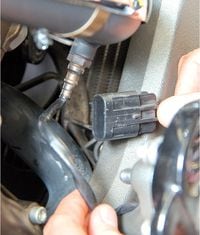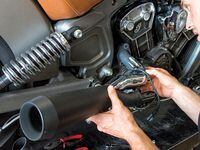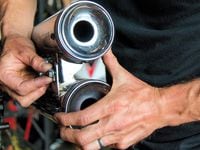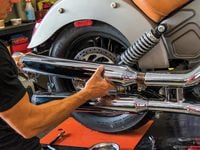A new pipe is high up on most owners’ list of desired modifications. Swapping exhausts is usually pretty easy, but the job will vary based on the style of bike and the number/layout of the cylinders. Singles are the easiest, while V-4s can be a nightmare. Whatever your layout, the steps are essentially the same as those outlined below.
In case you're wondering, we're putting the quieter Indian accessory pipes back on Hatano's long-term Scout.
Play the video below for a sample of what the Indian Straights slip-ons sound like:







/cloudfront-us-east-1.images.arcpublishing.com/octane/6DC3QAJSPJEQZF7KXNBOFGZX64.jpg)
/cloudfront-us-east-1.images.arcpublishing.com/octane/T2WRHM2RYVENHKM4TJKPGJHQZM.jpg)
/cloudfront-us-east-1.images.arcpublishing.com/octane/Y3L3XK4D5NHANIPLASAFHE4FAY.jpg)
/cloudfront-us-east-1.images.arcpublishing.com/octane/RP2FUYOZ4JDGRC666UKCWDLWPE.jpg)
/cloudfront-us-east-1.images.arcpublishing.com/octane/HT5PNEQC7VDXZHNYECPSKSYGTU.jpg)
/cloudfront-us-east-1.images.arcpublishing.com/octane/VN63PLIOMJCDJC3PWLIJQI5YHQ.jpg)
/cloudfront-us-east-1.images.arcpublishing.com/octane/SYIS3UGL7BGB5NEN5GSIVSFISM.jpg)
/cloudfront-us-east-1.images.arcpublishing.com/octane/H2NJJMCBSZCVHNDOGUQILJFMX4.jpg)
/cloudfront-us-east-1.images.arcpublishing.com/octane/K25WVPRMCVEDZJ7ZJK4BWE374Y.jpg)
/cloudfront-us-east-1.images.arcpublishing.com/octane/TQQGTGULURF5TOSK4FHQX7QKWY.jpg)

/cloudfront-us-east-1.images.arcpublishing.com/octane/THZ26BIH45AYBHU6WB527JTTCU.jpg)
/cloudfront-us-east-1.images.arcpublishing.com/octane/7OWQWAWJBFCGTAYQWBMWGNMNB4.jpg)
/cloudfront-us-east-1.images.arcpublishing.com/octane/4G5XKCDIHRCGRHVF7OPORG7ZX4.jpg)
/cloudfront-us-east-1.images.arcpublishing.com/octane/D2BDYKKNZ5GRHGDMI4PZTGRMME.jpg)

/cloudfront-us-east-1.images.arcpublishing.com/octane/UAY4WSZPOFDQRP4MCEXAKDFQOQ.jpg)

/cloudfront-us-east-1.images.arcpublishing.com/octane/X5CE3KSJHZHM5CUFGPZ7U26WB4.jpg)
/cloudfront-us-east-1.images.arcpublishing.com/octane/COWLTPGFAFGDDGJCTENYMA4VJM.jpg)
/cloudfront-us-east-1.images.arcpublishing.com/octane/H3PKUGPSUJFTND4RFPSI4OIDCE.jpg)
/cloudfront-us-east-1.images.arcpublishing.com/octane/UHGQA3MQDFCA3HLBWF7S76WH6Y.jpg)
/cloudfront-us-east-1.images.arcpublishing.com/octane/Q5EORCSTNFAVBJC4IYUHIKJTXQ.jpg)
/cloudfront-us-east-1.images.arcpublishing.com/octane/XIJ5FUFSP5A3NL7MOVZGJXAHC4.jpg)